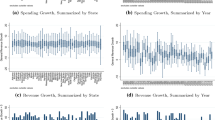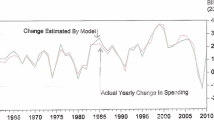Abstract
Procyclical government spending occurs when government expenditures increase at a faster rate than income in an economic upturn but fall at a faster rate in a recession. Voracity effects occur when competition for increased spending proves more effective as national income increases. Public choice theory can be applied to describe the distribution of fiscal power across different tiers of government to shed insight into competition for intergovernmental transfers. Politicians have electoral incentives to press for intergovernmental transfers but they also have electoral incentives to signal their ability to manage the economy. With this mix of incentives, the prediction is that intergovernmental transfers will be procyclical and that sub-central government spending will be more procyclical than central government spending. Public choice analysis of pressure for increased public spending predicts a specific pattern of cyclical government spending. This pattern can be observed when analyzing government expenditures in 20 OECD countries between 1995 and 2006.
Similar content being viewed by others
References
Abbott, A., & Jones, P. (2011). Procyclical government spending: patterns of pressure and prudence in the OECD. Economics Letters, 111(3), 230–232.
Akitoby, B., Clements, B., Gupta, S., & Inchauste, G. (2006). Public spending, voracity, and Wagner’s law in developing countries. European Journal of Political Economy, 22(4), 908–924.
Alesina, A., Campante, F. R., & Tabellini, G. (2008). Why is fiscal policy often procyclical? Journal of the European Economic Association, 6(5), 1006–1036.
Arreaza, A., Sørensen, B. E., & Yosha, O. (1998). Consumption smoothing through fiscal policy in OECD and EU countries (NBER Working Paper No. 6372).
Arena, M., & Revilla, J. E. (2009). Pro-cyclical fiscal policy in Brazil: evidence from the states (Policy Research Working Paper No. 5144). World Bank.
Bailey, S. J., & Connolly, S. (1998). The flypaper effect: identifying areas for future research. Public Choice, 95(3–4), 335–361.
Bergvall, D., Charbit, C., Kraan, D. J., & Merk, O. (2006). Intergovernmental transfers and decentralised public spending. OECD Journal of Budgeting, 5(4), 111–158.
Brennan, G., & Buchanan, J. M. (1980). The power to tax: analytical foundations of a fiscal constitution. Cambridge: Cambridge University Press.
Buchanan, J. M. (1972). Towards analysis of closed behavioral systems. In J. M. Buchanan & R. Tollison (Eds.), Theory of public choice, political applications of economics. Ann Arbor: University of Michigan Press.
Buchanan, J. M., & Tullock, G. (1962). The calculus of consent: logical foundations of constitutional democracy. Ann Arbor: University of Michigan Press.
Buchanan, J. M., & Wagner, R. E. (1977). Democracy in deficit. New York: Academic Press.
Cimadomo, J. (2008). Fiscal policy in real time (Working Paper No. 919). European Central Bank.
Cullis, J., & Jones, P. (2009). Public finance and public choice (3rd ed.). Oxford: Oxford University Press.
Darby, J., & Melitz, J. (2008). Social spending and automatic stabilizers in the OECD. Economic Policy, October, 716–756.
Dollery, B. E., & Worthington, A. C. (1996). The empirical analysis of fiscal illusion. Journal of Economic Surveys, 10(3), 261–297.
Dougan, W., & Kenyon, D. (1988). Pressure groups and fiscal illusion: the flypaper effect reconsidered. Economic Inquiry, 26(1), 159–170.
Fiorito, R. (1997). Stylized facts of government finance in the G-7 (Working Paper No. 97/142). International Monetary Fund, Washington.
Fiorito, R., & Kollintzas, T. (1994). Stylized facts of business cycles in the G7 from a real business cycles perspective. European Economic Review, 38(2), 235–269.
Forni, L., & Momigliano, S. (2004). Cyclical sensitivity of fiscal policies based on real time data. Applied Economics Quarterly, 50(3), 299–326.
Gavin, M., Hausmann, R., Perotti, R., & Talvi, E. (1996). Managing fiscal policy in Latin America and the Caribbean: volatility, procyclicality and limited creditworthiness (Mimeo). Inter-American Development Bank.
Henisz, W. J. (2000). The institutional environment for economic growth. Economics and Politics, 12(1), 1–31.
Hercowitz, Z., & Strawczynski, M. (2004). Cyclical ratcheting in government spending: evidence from the OECD. Review of Economics and Statistics, 86(1), 353–361.
Hindricks, J., & Myles, G. D. (2006). Intermediate public economics. Cambridge: MIT Press.
Hines, J. R., & Thaler, R. H. (1995). The flypaper effect. Journal of Economic Perspectives, 9(4), 217–226.
Jones, P., & Hudson, J. (1996). The quality of political leadership: a case study of John Major. British Journal of Political Science, 26(2), 229–244.
Kaminsky, G., Reinhart, C., & Vegh, C. (2004). When it rains, it pours: pro-cyclical capital flows and macroeconomic policies. In M. Gertler & K. Rogoff (Eds.), NBER macroeconomics annual: Vol. 19.
Lamo, A., Pérez, J. J., & Schuknecht, L. (2007). The cyclicality of consumption, wages and employment in the public sector of the Euro area (Working Paper No. 757). European Central Bank.
Lane, P. R. (2003). The cyclical behaviour of fiscal policy: evidence from the OECD. Journal of Public Economics, 87(12), 2661–2775.
Lane, P. R., & Tornell, A. (1996). Power, growth and the voracity effect. Journal of Economic Growth, 1(2), 213–241.
Miles, D., Myles, G., & Preston, I. (2003). The economics of public spending. Oxford: Oxford University Press.
Mueller, D. C. (2003). Public choice III (3rd ed.). Cambridge: Cambridge University Press.
Niskanen, W. (1971). Bureaucracy and representative government. Chicago: Aldine Atherton.
Oates, W. E. (1972). Fiscal federalism. New York: Harcourt Brace Jovanovich.
Oates, W. E. (1979). Lump sum intergovernmental grants have price effects. In P. Miezkowski & W. Oakland (Eds.), Fiscal federalism and grants-in-aid (pp. 23–30). Washington: The Urban Institute.
Oates, W. E. (1988). On the nature and measurement of fiscal illusion: a survey. In G. Brennan, B. S. Grewal & P. Groenewagan (Eds.), Taxation and fiscal federalism: essays in honour of Russell Mathews (pp. 65–82). Sydney: Australian National University Press.
Panizza, U. (1999). On the determinants of fiscal centralization: theory and evidence. Journal of Public Economics, 74(1), 97–139.
Peacock, A. (1992). Public choice analysis in historical perspective. Cambridge: Cambridge University Press.
Puviani, A. (1903). Teoria della illusione finanziaria. Palermo: Sandron.
Romer, T., & Rosenthal, H. (1980). An institutional theory of the effect of intergovernmental grants. National Tax Journal, 33(4), 451–458.
Talvi, E., & Végh, C. A. (2005). Tax base variability and procyclical fiscal policy in developing countries. Journal of Development Economics, 78(1), 156–190.
Tornell, A., & Lane, P. R. (1998). The voracity effect. American Economic Review, 89(1), 22–46.
Tullock, G. (1959). Some problems of majority voting. Journal of Political Economy, 67(6), 571–579.
Williams, A., & Siddique, A. (2008). The use (and abuse) of governance indicators in economics: a review. Economics of Governance, 9(2), 131–175.
Woo, J. (2009). Why do more polarized countries run more pro-cyclical fiscal policy? Review of Economics and Statistics, 9(4), 850–870.
Author information
Authors and Affiliations
Corresponding author
Rights and permissions
About this article
Cite this article
Abbott, A., Jones, P. Procyclical government spending: a public choice analysis. Public Choice 154, 243–258 (2013). https://doi.org/10.1007/s11127-011-9816-9
Received:
Accepted:
Published:
Issue Date:
DOI: https://doi.org/10.1007/s11127-011-9816-9




